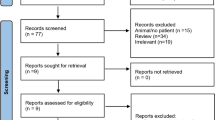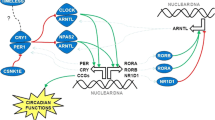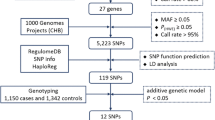Abstract
Disruption of the circadian rhythm or biological clock, which is regulated by a number of clock genes, including circadian locomotor output cycles kaput (CLOCK), period genes (PERs), and cryptochrome genes (CRYs), is a risk factor for breast cancer. We hypothesized that genetic variation in these clock genes may influence breast cancer risk. To test this hypothesis, we designed a hospital-based study that included 1,538 breast cancer patients and 1,605 healthy controls. We genotyped subjects for five single nucleotide polymorphisms (SNPs) and a length variant of the circadian clock genes and evaluated their associations with breast cancer risk. These polymorphisms were determined by TaqMan allelic discrimination assays and the polymerase chain reaction-restriction fragment length polymorphism method. Univariate logistic regression analysis showed that polymorphisms of the CLOCK and CRY1 genes were associated with breast cancer risk. We found that carriers of the CLOCK CT and combined CT+TT genotypes had a significantly higher risk of breast cancer than carriers of the CC genotype (aOR = 1.35, 95% CI = 1.12-1.63 and aOR = 1.30, 95% CI = 1.09–1.56, respectively). Carriers of the CRY1 GT genotype had a decreased risk of breast cancer (aOR = 0.84, 95% CI = 0.71–0.99). We also observed a lower risk of breast cancer in carriers of the CRY2 CC genotype who were ER-positive than in those who were ER-negative (OR = 0.15, 95% CI = 0.04–0.67). When stratified by the CLOCK genotype, patients with the CLOCK CT/ CRY2 CC genotypes had significantly lower cancer risk than those with the GG genotype (aOR = 0.36, 95% CI = 0.14–0.95). Individuals carrying both the CLOCK CC and PER2 AA genotypes had an increased cancer risk (aOR = 2.28, 95% CI = 1.22–4.26). Our study suggests that genetic variants of the circadian rhythm regulatory pathway genes contribute to the differential risk of developing breast cancer in Chinese populations.

Similar content being viewed by others
Abbreviations
- CLOCK:
-
Circadian locomotor output cycles kaput
- BMAL1:
-
Brain and muscle ARNT-like1
- SNPs:
-
Single nucleotide polymorphisms
- RFLP:
-
Restriction fragment length polymorphism
- PCR:
-
Polymerase chain reaction
- aORs:
-
Adjusted odds ratios
- CIs:
-
Confidence intervals
References
Parkin DM, Bray F, Ferlay J et al (2005) Global cancer statistics, 2002. CA Cancer J Clin 55:74–108. doi:10.3322/canjclin.55.2.74
Linos E, Spanos D, Rosner BA et al (2008) Effects of reproductive and demographic changes on breast cancer incidence in China: a modeling analysis. J Natl Cancer Inst 100:1352–1360. doi:10.1093/jnci/djn305
Burch JB, Walling M, Rush A et al (2007) Melatonin and estrogen in breast cyst fluids. Breast Cancer Res Treat 103:331–341. doi:10.1007/s10549-006-9372-z
Hankinson SE, Eliassen AH (2007) Endogenous estrogen, testosterone and progesterone levels in relation to breast cancer risk. J Steroid Biochem Mol Biol 106:24–30. doi:10.1016/j.jsbmb.2007.05.012
Yu H, Shu XO, Li BD et al (2003) Joint effect of insulin-like growth factors and sex steroids on breast cancer risk. Cancer Epidemiol Biomarkers Prev 12:1067–1073
Ravdin PM, Cronin KA, Howlader N et al (2007) The decrease in breast-cancer incidence in 2003 in the United States. N Engl J Med 356:1670–1674. doi:10.1056/NEJMsr070105
Kubo T, Ozasa K, Mikami K et al (2006) Prospective cohort study of the risk of prostate cancer among rotating-shift workers: findings from the Japan collaborative cohort study. Am J Epidemiol 164:549–555. doi:10.1093/aje/kwj232
Viswanathan AN, Hankinson SE, Schernhammer ES (2007) Night shift work and the risk of endometrial cancer. Cancer Res 67:10618–10622. doi:10.1158/0008-5472.CAN-07-2485
Schernhammer ES, Laden F, Speizer FE et al (2003) Night-shift work and risk of colorectal cancer in the nurses’ health study. J Natl Cancer Inst 95:825–828
Schernhammer ES, Kroenke CH, Laden F et al (2006) Night work and risk of breast cancer. Epidemiology 17:108–111. doi:10.1097/01.ede.0000190539.03500.c1
Maemura K, Takeda N, Nagai R (2007) Circadian rhythms in the CNS and peripheral clock disorders: role of the biological clock in cardiovascular diseases. J Pharmacol Sci 103:134–138. doi:10.1254/jphs.FMJ06003X2
Knutsson A (2003) Health disorders of shift workers. Occup Med (Lond) 53:103–108. doi:10.1093/occmed/kqg048
Costa G (2003) Shift work and occupational medicine: an overview. Occup Med (Lond) 53:83–88. doi:10.1093/occmed/kqg045
Stevens RG (1987) Electric power use and breast cancer: a hypothesis. Am J Epidemiol 125:556–561
Albrecht U (2002) Invited review: regulation of mammalian circadian clock genes. J Appl Physiol 92:1348–1355. doi:10.1152/japplphysiol.00759.2001
Ueda HR, Hayashi S, Chen W et al (2005) System-level identification of transcriptional circuits underlying mammalian circadian clocks. Nat Genet 37:187–192. doi:10.1038/ng1504
Delaunay F, Laudet V (2002) Circadian clock and microarrays: mammalian genome gets rhythm. Trends Genet 18:595–597. doi:10.1016/S0168-9525(02)02794-4
Canaple L, Kakizawa T, Laudet V (2003) The days and nights of cancer cells. Cancer Res 63:7545–7552
Zhu Y, Brown HN, Zhang Y et al (2005) Period3 structural variation: a circadian biomarker associated with breast cancer in young women. Cancer Epidemiol Biomarkers Prev 14:268–270
Hoffman AE, Yi CH, Zheng T et al (2010) CLOCK in breast tumorigenesis: genetic, epigenetic, and transcriptional profiling analyses. Cancer Res 70:1459–1468. doi:10.1158/0008-5472.CAN-09-3798
Zhu Y, Stevens RG, Leaderer D et al (2008) Non-synonymous polymorphisms in the circadian gene NPAS2 and breast cancer risk. Breast Cancer Res Treat 107:421–425. doi:10.1007/s10549-007-9565-0
Zhu Y, Leaderer D, Guss C et al (2007) Ala394Thr polymorphism in the clock gene NPAS2: a circadian modifier for the risk of non-Hodgkin’s lymphoma. Int J Cancer 120:432–435. doi:10.1002/ijc.22321
Chu LW, Zhu Y, Yu K et al (2008) Variants in circadian genes and prostate cancer risk: a population-based study in China. Prostate Cancer Prostatic Dis 11:342–348. doi:10.1038/sj.pcan.4501024
Sahar S, Sassone-Corsi P (2007) Circadian clock and breast cancer: a molecular link. Cell Cycle 6:1329–1331
Kang TH, Sancar A (2009) Circadian regulation of DNA excision repair: implications for chrono-chemotherapy. Cell Cycle 8:1665–1667. doi:8707[pii]
Cohen M, Lippman M, Chabner B (1978) Role of pineal gland in aetiology and treatment of breast cancer. Lancet 2:814–816. doi:10.1016/S0140-6736(78)92591-6
Filipski E, Li XM, Levi F (2006) Disruption of circadian coordination and malignant growth. Cancer Causes Control 17:509–514. doi:10.1007/s10552-005-9007-4
Shah PN, Mhatre MC, Kothari LS (1984) Effect of melatonin on mammary carcinogenesis in intact and pinealectomized rats in varying photoperiods. Cancer Res 44:3403–3407
Blask DE, Dauchy RT, Sauer LA et al (2003) Growth and fatty acid metabolism of human breast cancer (MCF-7) xenografts in nude rats: impact of constant light-induced nocturnal melatonin suppression. Breast Cancer Res Treat 79:313–320. doi:10.1023/A:1024030518065
Megdal SP, Kroenke CH, Laden F et al (2005) Night work and breast cancer risk: a systematic review and meta-analysis. Eur J Cancer 41:2023–2032. doi:10.1016/j.ejca.2005.05.010
Hansen J (2006) Risk of breast cancer after night- and shift work: current evidence and ongoing studies in Denmark. Cancer Causes Control 17:531–537. doi:10.1007/s10552-005-9006-5
Davis S, Mirick DK (2006) Circadian disruption, shift work and the risk of cancer: a summary of the evidence and studies in Seattle. Cancer Causes Control 17:539–545. doi:10.1007/s10552-005-9010-9
IARC (ed) (2006) IARC monographs on the evaluation of carcinogenic risks to humans. Preamble. International Agency for Research on Cancer, Lyon, France
Pronk A, Ji BT, Shu XO et al (2010) Night-shift work and breast cancer risk in a cohort of Chinese women. Am J Epidemiol 171:953–959. doi:10.1093/aje/kwq029
Acknowledgments
We thank Hongwei Han, Lei Lei, and Yanrui Zhao for their technical assistance. We also thank Ms. Kate Newberry of the Department of Scientific Publications at M. D. Anderson Cancer Center for editing this manuscript. This study was supported partially by grants from the National Natural Science Foundation of China (No. 30771844), the Tianjin Science and Technology Committee Foundation (No. 08ZCGH202000; 09ZCZDSF04400), the Major State Basic Research Development Program of China (973 Program) (No. 2009CB918903), and Tianjin Municipal Science and Technology Commission (No. 08JCZDJC23600). The Tissue Bank is jointly supported by Tianjin Cancer Institute and Hospital and National Foundation for Cancer Research (US).
Author information
Authors and Affiliations
Corresponding author
Electronic supplementary material
Below is the link to the electronic supplementary material.
Rights and permissions
About this article
Cite this article
Dai, H., Zhang, L., Cao, M. et al. The role of polymorphisms in circadian pathway genes in breast tumorigenesis. Breast Cancer Res Treat 127, 531–540 (2011). https://doi.org/10.1007/s10549-010-1231-2
Received:
Accepted:
Published:
Issue Date:
DOI: https://doi.org/10.1007/s10549-010-1231-2




